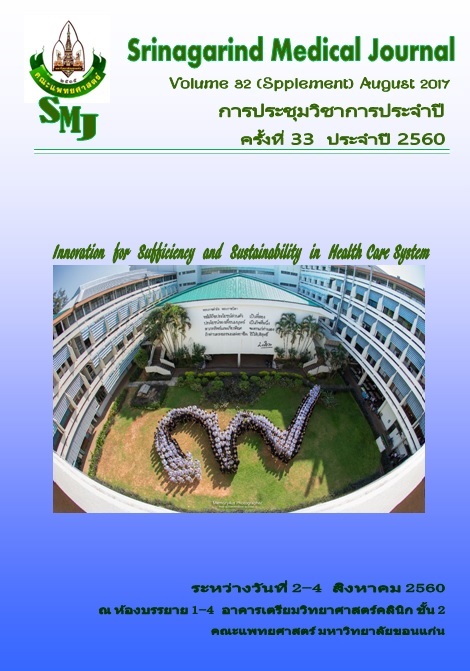Techniques for Postoperative Pain Management after Total Knee Arthroplasty in Srinagarind Hospital
Keywords:
knee arthroplasty, intrathecal morphine, local infiltration analgesia, numeric rating scale, acute postoperative pain, PCA (patient controlled analgesia)Abstract
Background and Objectives: Pain after total knee arthroplasty (TKA) is often severe, difficult to manage and leads to poor postoperative outcomes. Presently, there are several methods for controlling pain after TKA. We evaluated the analgesic effect and safety of the four most commonly used techniques for controlling pain after TKA in our hospital.
Methods: A retrospective observational descriptive study was conducted in 46 patients who underwent elective TKA under spinal anesthesia and received one of four different methods for controlling postoperative pain between January and December 2015. They were divided into four groups; group A (8) = received only intravenous morphine PCA, group B (6) = received both intrathecal morphine and intravenous morphine PCA, group C (19) = received both local infiltration analgesia (LIA) and intravenous morphine PCA and group D (13) = received intrathecal morphine, LIA and intravenous morphine PCA. The data were reviewed and collected from pain assessment forms and anesthetic records. Morphine consumption from PCA devices and postoperative numeric rating pain scores (NRS) on day 1 and 2 were recorded and used for assessing the effectiveness of pain relief. Adverse effects such as nausea and vomiting, itching, sedation, respiratory depression, local anesthetic toxicity and seizure were recorded for determining the safety.
Results: On postoperative day 1, morphine consumption in group D and the NRS upon movement in group C and D were significantly lower compared with group A (p=0.006 and 0.002, respectively). However, the resting NRS on postoperative day 1 and 2, the NRS upon movements and morphine consumption on day 2 were not different. The most common adverse effects in all groups were nausea and vomiting. Respiratory depression was the only serious adverse effect which occurred in a patient group D. Most of patients rated the highest satisfaction score, with group D having the highest number of patients (84.6%).
Conclusions: Among the four different methods, combined intrathecal morphine with local infiltration analgesia (LIA) and intravenous morphine PCA was the best method for achieving postoperative day 1 pain control after TKA. The LIA combined with intravenous morphine PCA was also effective, but only for pain upon movement on postoperative day1.




